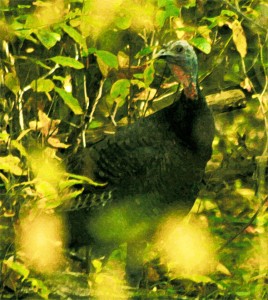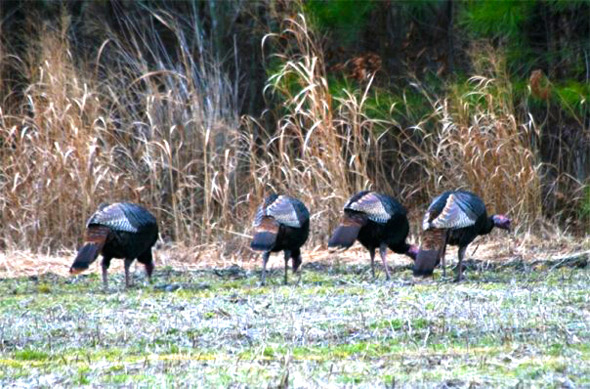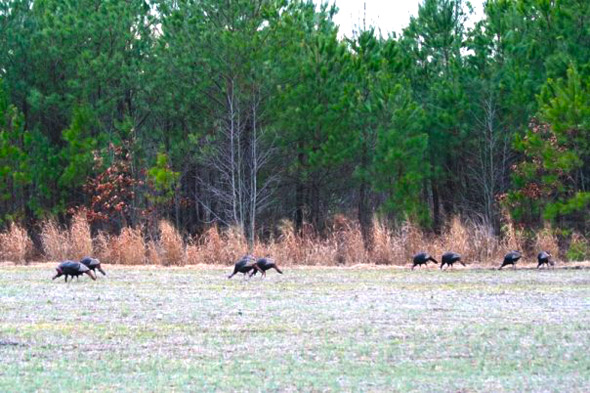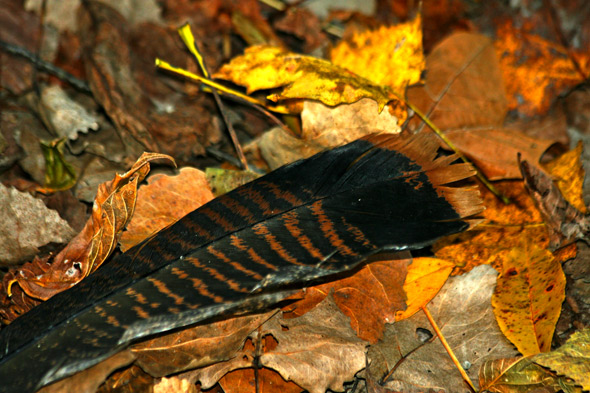 As many of us sit down for Thanksgiving each year for a delicious oven-baked meal, we rarely consider the history behind our feast. The turkey most of us eat is a domesticated cousin of a wild counterpart that still lives right here in our backyard. Before the majority of food turkeys were raised on farms, the eastern wild turkey, a subspecies found from Maine to Florida, was over hunted. Combine this with the habitat loss that occurred up to the early 1940’s when its numbers were said to have dropped down to as low as 30,000 individuals across the United States. Luckily, towards the later part of the twentieth century populations rebounded as a result of conservation and breeding efforts. Since then wild turkeys have remained stable with over 30,000 estimated to inhabit Maryland alone. They are documented to be much more numerous in western Maryland and the eastern shore but there is a still a strong presence even in the more developed central and southern areas. Now turkeys exist in such healthy numbers that managed hunting and conservation may coincide.
As many of us sit down for Thanksgiving each year for a delicious oven-baked meal, we rarely consider the history behind our feast. The turkey most of us eat is a domesticated cousin of a wild counterpart that still lives right here in our backyard. Before the majority of food turkeys were raised on farms, the eastern wild turkey, a subspecies found from Maine to Florida, was over hunted. Combine this with the habitat loss that occurred up to the early 1940’s when its numbers were said to have dropped down to as low as 30,000 individuals across the United States. Luckily, towards the later part of the twentieth century populations rebounded as a result of conservation and breeding efforts. Since then wild turkeys have remained stable with over 30,000 estimated to inhabit Maryland alone. They are documented to be much more numerous in western Maryland and the eastern shore but there is a still a strong presence even in the more developed central and southern areas. Now turkeys exist in such healthy numbers that managed hunting and conservation may coincide.
Turkeys are a unique part of our local ecosystem not only for other wildlife species but have been a food source for the people of our land throughout history. The turkey is imbedded in our culture as the Thanksgiving staple with stories being taught to every child about the early settlers and the Native Americans. Ben Franklin is often quoted as preferring the turkey over the bald eagle as the national symbol in his letter describing that he favored the turkey’s dignity over the eagle’s propensity to scavenge for its food. Few of us other than the sportsmen who look forward to the fall and spring hunting seasons ever give the modern wild turkey much thought.
I am always delighted when I encounter turkeys in the wild. Sometimes you can find them feeding on the edge of a recently harvested farm field. Other times you can be hiking down a peaceful forest trail only to have the tranquility shattered with the bellowing gobble of a turkey which is often immediately followed by a lightning fast blur as the dinosaur-like creatures evade your presence. We envision turkeys as awkward, bumbling animals but in reality wild turkeys can actually move with grace and precision. They may not be able to soar the thermals like a red-tailed hawk but if they can’t get where they need to go by running, they (if only low and for short distances) can certainly fly.
While most of us won’t be eating a native eastern wild turkey at dinner, we can still consider all that this bird represents to us. It is part of our cultural heritage. It is an economic benefit to our state that brings many sportsmen great joy. It is a valued part of our ecosystem, fulfilling a unique niche in the food chain. It represents yet another species driven down the road towards extinction that was able to be turned around and restored to healthy numbers. The turkey is a great symbol for much of the wildlife that we should be thankful still exists. Although it may not be as grandiose as the bald eagle, the wild turkey is a natural wonder that deserves our respect and appreciation.




